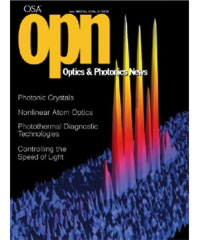
June 2002 Issue
Feature Articles
Arrayed Waveguide Grating Technology
The capacity of arrayed waveguide gratings (AWGs) has increased dramatically, to the point that as many as 400 channels can now be incorporated into a single wafer. A capacity of 1080 channels with 25-GHz channel spacing has been reported in tandem AWGs with a multichip configuration. Although the total capacity of the transport can be increased to the terabit level by use of wavelength-division multiplexing, signal processing in the electrical layer remains a serious problem because of the limits in electrical signal processing speed. The optical signal processing devices that can play an important role in solving this issue include dispersion slope equalizers, polarization-mode dispersion (PMD), equalizers, temporal pulse shapers, and optical label recognition circuits.
by Katsunari OkamotoLight pulses can be made to propagate with group velocities exceeding the speed of light in a vacuum or, at the opposite extreme, to come to a complete stop.
by Raymond Y. Chiao and Peter W. MilonniInteratomic interactions can introduce nonlinear behavior into a system of trapped ultracold atoms, similar to the dynamics of light propagating in a refractive nonlinear medium. Bose-Einstein condensates are now providing the means for studying coherent nonlinear dynamics with dilute atomic systems.
by Brian P. Anderson and Pierre MeystrePhotonic Crystals: An Engineering Perspective
Photonic crystal devices posses a unique ability to control and localize light. This article discusses design and fabrication methods used to engineer photonic crystal devices for use in chip-scale photonic systems.
by Shu Namiki and Yoshihiro EmoriPhotothermal Diagnostic Technologies
Photothermal diagnostics (PTD) has been responsible for the emergence of a growing number of revolutionary new measurement technologies in both academic and industrial environments. The common element among these diffusion-based methodologies is that they are complementary to purely optical detection techniques because they rely on the detection of optically produced thermal phenomena, or on other processes that result in the occlusion of thermal energy or the emission of thermal infrared photons.
by Andreas MandelisSlow, Ultraslow, Stored, and Frozen Light
The article illustrates recent experiments in which light is slowed, frozen, reversed, and stored in hot atomic vapors via electromagnetically induced transparency.
by Yuri Rostovtsev, Olga Kocharovskaya, George R. Welch, and Marlan O. ScullyDepartments and Columns
Let There Be Light...and Color
This year, OSA sponsored four optics workshops in conjunction with the National Science Teachers Association (NSTA) annual meeting.
An Executive Secretary for OSA
In the third installment of John N. Howard’s column on the history of OSA, the appointment of the Society’s first executive secretary signals the beginning of a new era.
Optics Technology Plays Key Role in Afghan War
The war in Afghanistan is a demonstration of the central role optics has played in establishing the global supremacy of U.S. armed forces—a role that is guaranteed to continue for the foreseeable future.
Also in this Issue


![Manual probe system with needles for test of semiconductor on silicon wafer. [A. Morozov / Getty]](https://opnmedia.blob.core.windows.net/$web/opn/media/images/articles/2025/1125/departments/202511-cover-web.jpg?ext=.jpg)
![Researcher Clara Saraceno in the lab. [Image by Carsten Behler Photography]](https://opnmedia.blob.core.windows.net/$web/opn/media/images/articles/2025/1025/departments/202510-cover-web.jpg?ext=.jpg)
